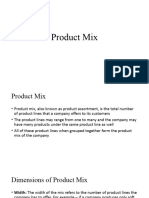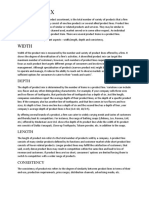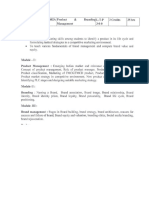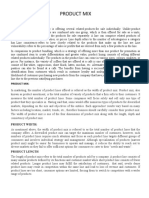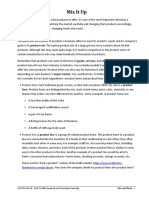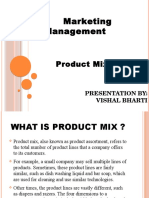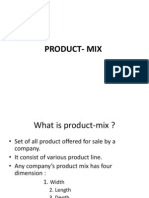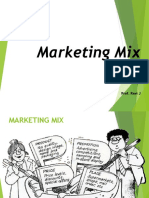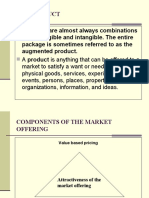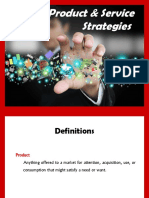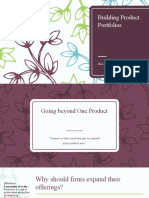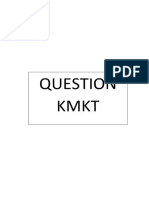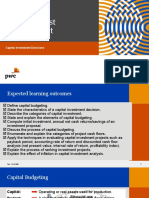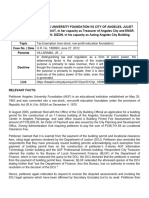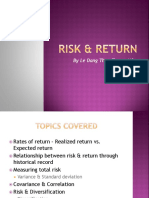ANSWERS (Product Strategy)
There are five levels of a product by applying to a hotel chain and they are,
1. Core benefit - The core benefit is the fundamental need or wants that the customer satisfies
when they buy the product or service. The core benefit of a hotel is to provide some where to
rest or sleep when away from home.
2. Generic product - It is a basic version of the tangible product or service which is made up of only
those features that are necessary for it to function. This could mean a bed, towels, a bathroom,
a mirror, wardrobe etc. in hotels.
3. Expected product - It is the set of features that the customers expect when they buy the product
or service. This would include clean sheets, clean towels, Wi-fi, clean bathroom, etc in hotel
chains.
4. Augmented product - It refers to any product variations, extra features or services that help
differentiate the product from its competitors. This could be a resident care taker service in
hotel, free map of town in every room, etc in hotel.
5. Potential product - It includes all augmentations and transformations the product or service
might undergo in the future. This means to continue to surprise and delight customers the
product must be augmented. In hotels, this could mean a different gift like chocolates, luxury
items etc. placed in the room each time a customer stays. By this way the hotel will continue to
delight and surprise the customers.
�2) Product mix - is a set of total number of product lines that the seller offers in the market to its
buyers. The company may have one or several product lines and each product lines may have
several products. When these product lines get together are known as product mix of a
company. Product mix has 4 dimensions. Let us see about them in detail.
i) Product mix width - Width or breadth is the company's product mix that means the total
number of product line that a company offers to sell. For instance, if a company offers milk and
yogurts, this indicates that its product mix has two lines. Similarly a cosmetic company
manufactures 4 different types of products, and then its product mix width is 4.
ii) Product mix length - this means the total number of products within a company's product
line. Ex - If a company has 5 product lines and 10 products each under these product lines, the
length of mix is 50 (10*5). In other words, length of the product mix refers to the total number
of products in a mix.
iii) Product line depth - Depth of product means the total number of products a company offers
within a certain product line. There may be different variations in the products ex - size, flavor,
taste, etc. For example - Colgate toothpaste company sells four sizes and two flavors. So the
depth is equal to 8 (4*2)
iv) Product mix consistency - The consistency of a product mix is the close relationship between
different product lines in term of use, productions and distribution. The more product variation
means the less product consistency. For example, a diary company has two product lines milk
and yogurt. Both the lines have same user and distribution channel. Due to low product
variations, the consistency is high.
Or, Product Mix Width:
Width or breath is the company’s product mix that means the total number of product lines that
a company offers to sell. For instance, if a company offers milk and yogurts, this indicates that its
product mix has two lines. Similarly, a cosmetic company manufactures four different types of
products – jewellery, cosmetics, fashion and household items. Its product mix width is 4.
Product Mix Length:
The length of product mix means total number of products within a company’s product lines.
For example, if a company has 10 product lines and each line has 3 product variations then
product mix length is (10×3) = 30. Length of the product mix refers to the total number of
products in the mix. If a company has 5 product lines and 10 products under each product lines,
the length of the mix will be 50 [5 x 10].
�Product Line Depth:
Depth of product line means the total number of products a company offers within a certain
product line. There may be different variations in the product e.g. size, flavor, taste and many
other characteristics. For example, Medicam toothpaste sells four sizes and two flavors mean it
has a depth of eight. Another thing I want to discuss is average depth of product line. Suppose a
company first line depth is 8 and second one is 10 the average depth is 19.
Consistency:
The consistency of a product mix is the close relationship between different product lines. The
more product variation means less product consistency. For example, a dairy company has two
product lines milk and yogurt. Both the lines have same users and distribution channels due to
low product variation and high product mix consistency. Take another example of Philips
Electronics with 7 product lines having high production mix variation and low consistency.
Or, 'Product mix' is the term used to describe all products a particular seller offers for sale. The
products may be related to each other in terms of usage or application and such related
products form a product line.
A product mix width refers to the number of product lines offered by a seller to the customers.
For example if a company provides products in the fields of skincare, hair care, lip care, and
deodorants, the product line width of the company is four.
Product mix length is the total number of items a company has in different product lines of the
mix. If the company has 3 product lines and 5 items in each product line, the product mix length
is 15.
Product mix depth refers to the number of variants of each product offered in the product mix.
For example if a tea company provides three varieties of tea in two different sizes, then the
product mix depth is 6.
Consistency refers to the close relatedness of different product lines in terms of end-users,
production systems, distribution channels or some other way. For example, the product mix of a
company is told to be consistent when the product lines use the same distribution channels. It is
said to be less consistent if the product lines are used for different functions by the customers.
�Or, Product mix
The complete range of products present within a company is known as the product mix. If a
company has only a single product, than it is understood that the demand of the product is very
high or the company does not have the resources to expand the number of products it has.
Generally, most companies nowadays realize the importance of product diversification.
However, if the business market is any example, than all the top companies have multiple
products. Coca cola, Apple, Microsoft, Nestle, Hindustan unilever, Pharmaceutical companies, so
on and so forth. These companies need to have a wide product portfolio to be present in the
market and to have a sustainable business model.
Four elements of product mix
1. Product mix width
The product mix width means number of product line carry by business. The width of the
product mix is equal to the number of product lines within a company. Example, if there are 4
product lines within the company and 10 products within each product line, than the product
line width is 4 only. Thus, product line width is a depiction of the number of product lines which
a company has.
2. Product mix length
Product mix length means total number of items in product line. If a company has 4 product
lines, and 10 products within the product line, than the length of the product mix is 40. Thus,
the total number of products against the total number of product lines forms the length of the
product mix. This equation is also known as product mix length.
3. Product mix depth
Product mix depth means number of version offered of each product in line. Depth is closely
related to length in the product mix in the sense that it offers the consumer options when
selecting a given product. Depth refers to the different ways that you can buy a particular
product in a product line. For instance, you can buy soft drink in a 2-Liter bottle, a six or 12-pack
of cans, a 20-ounce bottle or other sizes. You can buy dish soap in liquid, powder or gel form.
These options further enhance your flexibility as a buyer.
4. Consistency
The consistency element of the product mix refers to the connection between products within
the product line and the way they reach the consumer. For manufacturers, consistency refers to
�how closely related production processes are for various products. The more consistent
production is the more efficient and cost-effective. For retailers, consistency in a product mix
makes it easier to perform suggestive selling and recommend close products. Distinct products
in the mix typically translate to a unique selling process for that product.
�3) Product line extension refers to the marketing strategy of a company where it uses its
established brand name to extend its products line by offering additional products. These
additional products are often related to the former product.
E.g. of a product line extension is when an ice cream manufacturer introduces new flavors of ice
cream or a luxurious car maker brings out a new model for the middle class.
Brand extension is a strategy used by the company by using an established brand image to
market an entirely different product. The new product may or may not be related to the former
product.
For example - Apple started as a company that manufactured personal computers and forayed
into mp3 players and mobile phones. Here, Apple used its established brand image to market
different products.
4) Product Augmentation Strategy - Product augmentation is a marketing strategy that brands
and businesses use to distinguish their products and offers from those of competitors and to
make them more valuable than what competitors are offering. To the customer, it is like getting
more value for their money.
The word augmentation means to make larger or to expand. ... That is, product augmentation is
anything that adds value to the customer OUTSIDE of the actual product design and its product
features.
Physical Augmentation –
�4) Physical or recommendation is that one that alters the persons inherent physical capability by
implanting on hosting a technology within their bodies this falls into four categories
1- Service augmentation: it involves hearing vision and perception. Example for virtual reality
augmentation and augmentation reality.
2- Biological function augmentation: in this it include exoskeleton and prosthetic and are used to
replace or enhance search capabilities.
3- Brain augmentation
4- Genetic augmentation: somatic genetics and cell therapies are used to treat children.
B) Service augmentation describes the doors part of the service offering that the customer is
aware of and respond to but not a part of the product core. Example of communication and
reputation.
D) brand augmentation - it mainly represent benefit of association related with the product. The
SAR aspect which differentiates the brand from other similar product. Example is that automatic
lube oil the benefit can be long durability of the lube oil.
E) Packaging augmentation - with traditional packaging customers are limited to the information
that they can glean from the packaging itself which means that companies are limited to what
information they can choose to share

